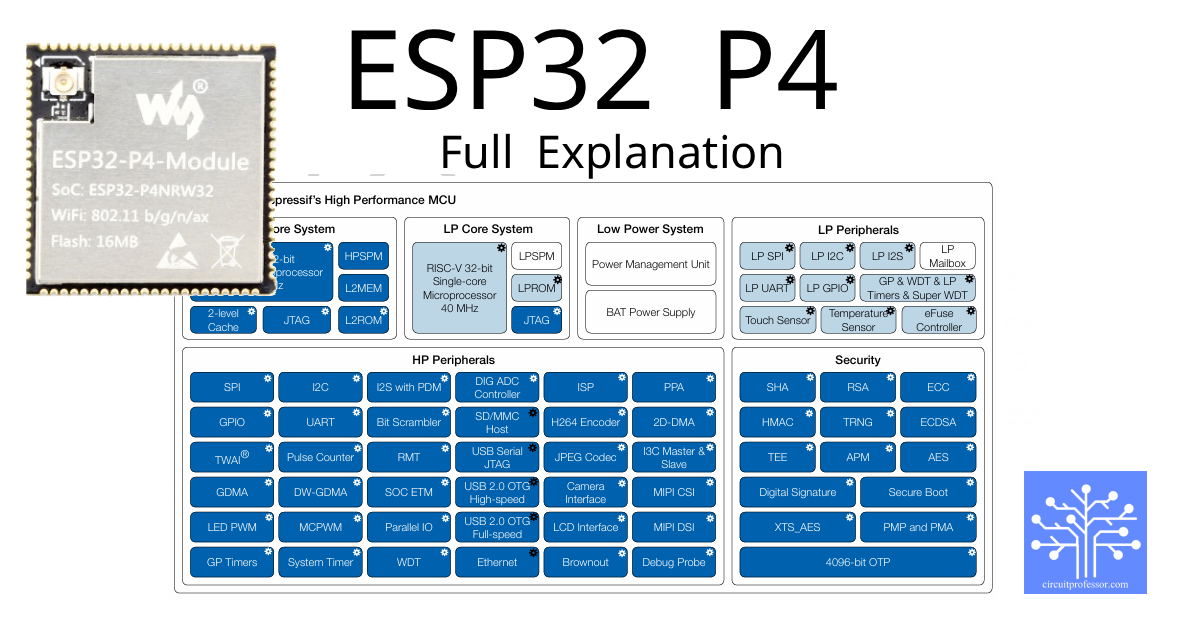ESP32 is the most used microcontroller in the top 5 microcontroller world like Arduino Uno, STM32, Raspberry Pi Pico, and MSP430. Mainly over 3,400 companies use it worldwide and the dominant market segment is IoT device sides. Mainly 8 types of ESP32. Original ESP32 with Dual-core Xtensa, ESP32-S2 with Single-core, ESP32-S3 with Dual-core AI/ML, enhanced peripheral, ESP32-C3 with RISC-V, low cost, ESP32-C6 with Wi-Fi 6, Thread, ESP32-H2 with Zigbee/Thread/BT Low Energy, ESP32-C5 with Dual-band Wi-Fi 6, RISC-V, and finally ESP32 P4 with Dual-core RISC-V CPU, multimedia.
Mainly, ESP32 P4 comes in 5 variants.
| esp32 p4 variants | Key features |
| ESP32 P4 DevKit | Full dev board, Ethernet, USB, camera, MIPI |
| ESP32 P4 Pico | Compact, smaller form factor, GPIO headers |
| ESP32 P4 Smart 86 Box | 4″ Touchscreen, Ethernet, camera, audio |
| ESP32 P4 Module | Bare module, large PSRAM, video processing |
| Firebeetle 2 Board | Integrated components, dev board variant |
In this article, we explore the key features of the ESP32 P4
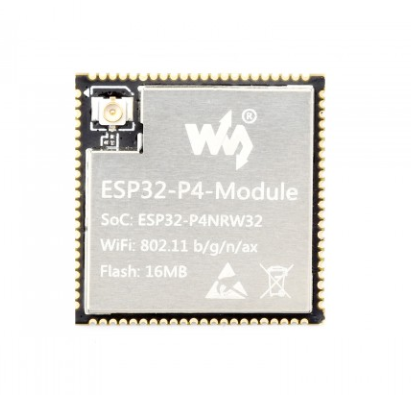
Click to jump
- Architecture and Core Specifications (Jump)
- HP core and LP core
- FPU
- Memory Architecture(jump)
- On-Chip Memory
- External Memory Support
- Multimedia and Display Capabilities(jump)
- Display Interfaces
- Image and Video Processing Hardware Accelerators
- Human Machine Interface (HMI) Support
- Security Features(jump)
- Core Security Components
- Peripheral Interfaces(jump)
- Standard Interfaces
- High Speed Connectivity
- Comparison with Previous ESP32 Models(jump)
Architecture and Core Specifications
HP core and LP core
The ESP32 P4 features a dual-core RISC-V CPU capable of running at speeds up to 400 MHz, equipped with single-precision floating-point unit (FPU) and AI instruction extensions. This represents a fundamental shift from the Tensilica Xtensa architecture used in earlier ESP32 models to the open-source RISC-V instruction set architecture (ISA).Also ,The SoC integrates an LP-Core (Low-Power Core) running at up to 40 MHz, crucial for supporting ultra-low-power applications that may intermittently require high computing power. This dual-domain architecture allows the high-performance cores to remain dormant during periods of low activity, significantly reducing power consumption.
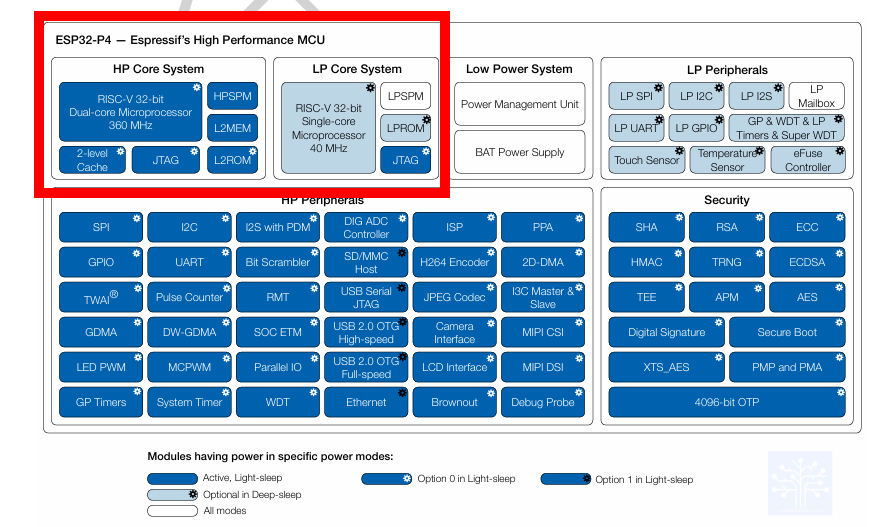
FPU
A single-precision floating-point unit (FPU) is a specialized part of a processor designed to efficiently perform arithmetic operations on floating-point numbers, specifically those represented in 32-bit IEEE 754 format. These are numbers that include decimals like 3.14 or -0.007and are essential for scientific, engineering, and graphics computations.In FPU, the addition, subtraction, multiplication, and division, square roots, trigonometric functions, and more (depending on implementation) are performed.
It also handles conversion between integer and floating-point formats. read more…
Memory Architecture
On-Chip Memory
768 KB On-Chip SRAM: This is high-speed memory embedded in the ESP32 P4 chip itself. When an external PSRAM (pseudo-static RAM) is connected, this SRAM can serve as a cache to the external memory, allowing faster data access and improving performance when processing large datasets.
8 KB Zero-wait TCM (Tightly Coupled Memory) RAM: This memory is tightly coupled with the CPU cores and provides extremely fast access with zero wait states, ideal for critical data buffers or latency-sensitive code sections that must execute quickly without delay.
128 KB High-Performance (HP) ROM and 16 KB Low-Power (LP) ROM: ROM includes permanent code such as bootloader and essential firmware routines. The differentiation supports both high-performance and low-power tasks.
32 KB Low-Power SRAM: A smaller SRAM dedicated for the low-power core to use in energy-efficient modes, helping balance performance and power consumption.
External Memory Support
PSRAM up to 32 MB: External pseudo-static RAM can be connected to expand the memory available at runtime. PSRAM is crucial for handling large image buffers, AI models, or complex multimedia data that exceed internal SRAM capacity.
External Flash Memory (typically up to 16 MB): The chip supports external SPI or QSPI flash memory up to roughly 16 MB or more, used mainly for program storage and large data assets.
Eight Channels High-Speed SPI Flash/PSRAM Support: Multiple SPI channels allow parallel, high-speed access to external memory devices, enabling fast data throughput. This is critical for use cases like video streaming or image processing demanding high bandwidth.
Multimedia and Display Capabilities
The ESP32 P4 microcontroller represents a leap forward in integrating advanced multimedia functions into a compact, high-performance System on Chip (SoC). Designed with modern multimedia and human-machine interface (HMI) applications in mind, it offers a versatile set of hardware accelerators for image, video, and display processing, enabling developers to build sophisticated, responsive, and visually rich embedded solutions.
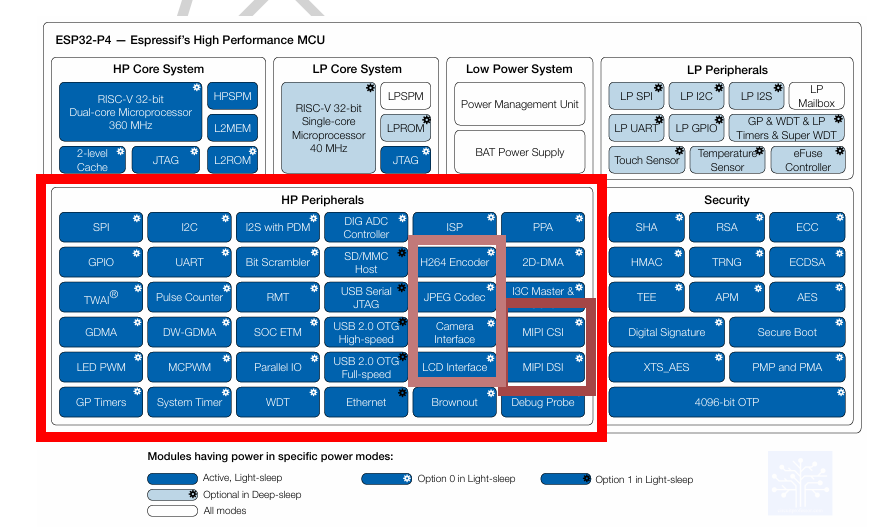
Display Interfaces
Central to the ESP32-P4’s multimedia prowess is its support for the MIPI-CSI and MIPI-DSI interfaces, which are industry-standard high-speed serial interfaces:MIPI-CSI (Camera Serial Interface): Facilitates connection of high-resolution cameras, supporting raw image data directly from sensors.MIPI-DSI (Display Serial Interface): Enables driving high-resolution displays with low pin count and high bandwidth.
Specifically, the ESP32-P4 supports:
Up to 1080p resolution for both camera input and display output, suitable for HD multimedia applications.Compliance with MIPI D-PHY v1.1 standard, operating at up to 2-lanes × 1.5 Gbps each, totaling 3 Gbps bandwidth for crisp, fluid image and video transmission.A parallel display interface for backward compatibility with legacy hardware, broadening application potential.Real-time H.264 video encoding hardware capable of handling 1080p video at 30 frames per second, delivering efficient video compression for streaming or storage.This combination enables the ESP32-P4 to handle complex video input/output tasks while maintaining power efficiency and small form factor.
Image and Video Processing Hardware Accelerators
At its core, the ESP32-P4 integrates dedicated accelerators to optimize multimedia data handling directly in hardware, offloading CPU load and boosting efficiency:
H.264 Encoder: Provides fast, hardware accelerated video compression at 1080p@30fps. This is crucial for applications like video conferencing, surveillance, and real time streaming where performance and low latency matter.
Image Signal Processor (ISP): Processes raw camera data from sensors, performing tasks such as noise reduction, demosaicing, color correction, gamma correction, and sharpening all critical for clear, high-quality image capture and rendering.
Pixel Processing Accelerator (PPA): Specialized hardware for efficient pixel-level operations crucial in graphical user interfaces (GUIs), including image transformations like rotation, scaling, and mirroring.
2D-DMA Controller: Accelerates 2D graphics operations and supports JPEG encoding and decoding peripherals, enhancing performance for static and animated images.
JPEG Codec: Dedicated hardware support for JPEG compression and decompression, facilitating quick image handling for photo storage, transfer, or display.
Collectively, these components enable the ESP32 P4 to handle rich multimedia workloads, from live video encoding to sophisticated GUI rendering, with minimal CPU intervention.
Human Machine Interface (HMI) Support
Reflecting the trend towards more interactive and responsive embedded devices, the ESP32 P4 enhances HMI capabilities .The Capacitive touch input support capable of recognizing multiple simultaneous touch points, enabling intuitive and smooth user interactions suitable for modern touchscreens.Integrated speech recognition features combined with advanced audio processing, allowing natural, voice driven interfaces.Audio codec integration supporting speaker and microphone connections, along with interfaces for high fidelity audio input and output, meeting needs of voice assistants, smart speakers, or communication devices.
These HMI features make the ESP32 P4 a prime choice for smart displays, interactive kiosks, voice-activated controls, and similar applications.
Security Features
Strong security is at the heart of ESP32 P4, with features such as Secure Boot, Flash Encryption, cryptographic accelerators, and TRNG (True Random Number Generator).
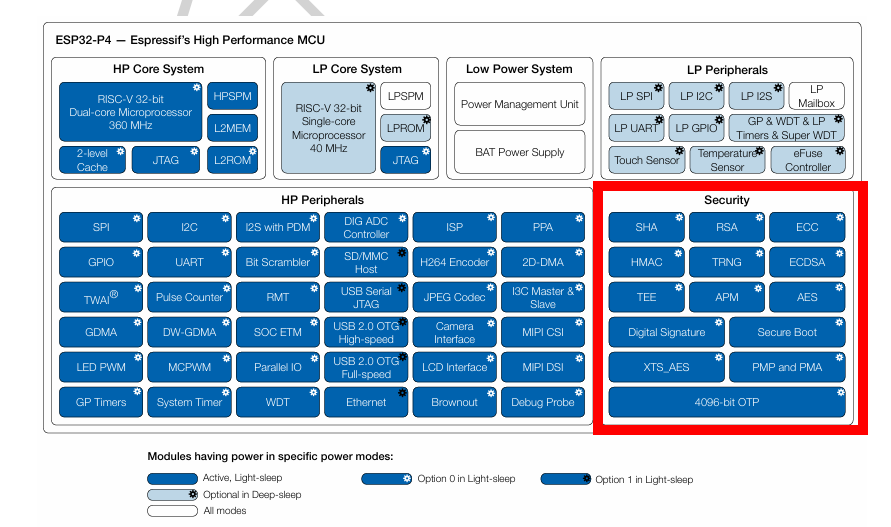
Core Security Components
The ESP32 P4 employs a comprehensive suite of hardware security features to ensure robust protection at every stage of device operation. Secure Boot is the foundation, verifying the authenticity of firmware before execution so that only trusted, signed code can run, effectively blocking unauthorized or tampered software. Flash Encryption further safeguards sensitive data by encrypting all information stored in the device’s flash memory, making it unreadable to attackers even if physically accessed.
The chip integrates dedicated cryptographic accelerators for algorithms like AES, SHA, ECC, and RSA, enabling fast, hardware-based encryption, decryption, and authentication processes essential for secure communications and data integrity. Key management is handled by a Digital Signature Peripheral and a dedicated Key Management Unit (KMU), which together ensure that private keys are generated and stored securely within the SoC, never exposed in plain text to software or vulnerable to physical extraction.
Finally, hardware access protection mechanisms enforce strict access permissions and privilege separation, preventing unauthorized code or users from accessing critical resources or escalating privileges, thereby maintaining a secure execution environment throughout the device’s lifecycle.
Peripheral Interfaces
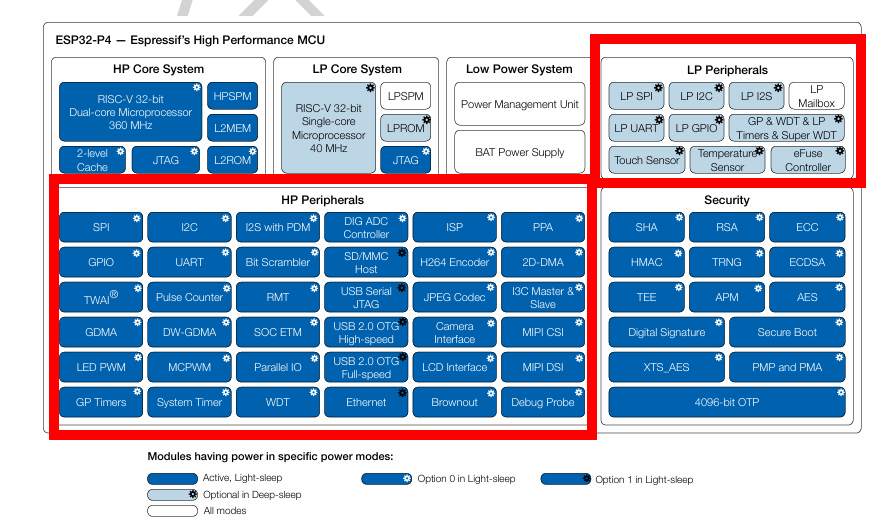
GPIO and Standard Peripherals
ESP32-P4 has more than 50 programmable GPIOs, significantly more than any other Espressif SoC to date. The boards expose 45 programmable GPIO pins, and up to 55 GPIOs are mentioned in some specifications.
Communication Interfaces
The ESP32-P4 supports extensive peripheral connectivity:
Standard Interfaces
The ESP32 P4 integrates a rich array of peripheral interfaces, making it exceptionally versatile for embedded and IoT applications. It features 5 UART interfaces that support asynchronous communication standards like RS232 and RS485, as well as IrDA, with data rates reaching up to 5 Mbps which is ideal for robust serial communication in industrial and consumer devices.
Multiple SPI interfaces are available, supporting both master and slave modes and a wide range of protocols, including 1-bit SPI, Dual SPI, Quad SPI, QPI, Octal SPI, and OPI, which allow for flexible, high speed data exchange with external memory and sensors.
For inter device communication, the chip offers two I2C bus interfaces, each supporting standard (100 Kbit/s), fast (400 Kbit/s), and high-speed (800 Kbit/s) modes ensuring compatibility with a broad spectrum of peripherals.
Additionally, the ESP32 P4 includes one I3C host and one I3C slave interface, providing advanced features like dynamic address allocation and in band interrupts for next-generation sensor networks. Beyond these, the SoC supports other essential interfaces such as I2S for audio, LED PWM and MCPWM for motor and lighting control, RMT for remote protocols, ADC and DAC for analog signal conversion, and TWAI™ for CAN bus communication, collectively enabling comprehensive connectivity and control in complex embedded systems.
High Speed Connectivity
Finnaly, The ESP32 P4 delivers advanced high-speed connectivity options essential for modern embedded and IoT systems. It features a USB OTG 2.0 High-Speed interface and which enabling both device and host functionality with rapid data transfer rates which is ideal for connecting peripherals, updating firmware, or supporting USB-based communication protocols.
The integrated Ethernet interface provides reliable, wired network connectivity for applications requiring stable and secure data transmission, making it suitable for industrial automation, smart home hubs, and networked multimedia devices.
Additionally, the SDIO Host 3.0 interface supports high-speed communication with external storage devices and wireless modules, facilitating fast data access and efficient expansion for demanding use cases such as multimedia streaming, data logging, and wireless networking.
Comparison with Previous ESP32 Models
| Feature | ESP32 (Original) | ESP32-S3 | ESP32-C3 | ESP32-P4 |
| Release Year | 2016 | 2020 | 2020 | 2023-2024 |
| CPU Architecture | Dual-core Xtensa LX6 | Dual-core Xtensa LX7 | Single-core RISC-V @ 160 MHz | Dual-core RISC-V @ 400 MHz |
| Max Clock Speed | 240 MHz | 240 MHz | 160 MHz | 400 MHz |
| GPIO Count | ~34 | 45 GPIOs | ~22 | 50+ GPIOs |
| Wi-Fi | WiFi 4 (802.11 b/g/n) at 2.4 GHz | WiFi 4 (802.11 b/g/n) at 2.4 GHz | WiFi 4 (802.11 b/g/n) at 2.4 GHz | None (requires external) |
| Bluetooth | BLE 4.2 | BLE 5.0 | BLE 5.0+ | None (requires external) |
| FPU | Yes | Yes | No | Yes |
| Flash | 4 MB typical | Up to 8 MB | 4 MB typical | 16 MB typical |
| Deep Sleep Power | ~100 µA | ~100 µA | ~5 µA | Not specified |
| Video Processing | No | No | No | H.264 encoder, ISP, PPA |
Espressif is well known to deliver cost-effective solutions, with initial estimates suggesting the ESP32 P4 DevKit will be in the EUR 10-15 price range. As of late 2024, the chips are transitioning from engineering samples to mass production.

